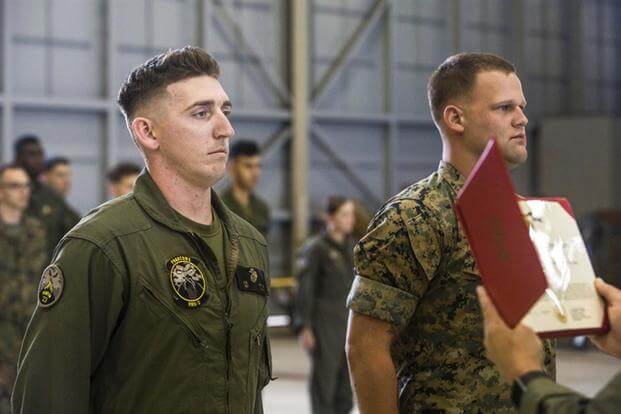When the Defense Department first floated the idea of a dedicated award for drone operators, some laughed.
But now all the services have a special "remote" device to recognize outstanding work of service members who operate unmanned aerial systems in combat zones -- and two Marines are now the first of their service to wear it.
Sgts. Ethan Mintus and Joseph Latsch, both assigned to Marine Unmanned Aerial Squadron 3, were awarded Navy and Marine Corps Achievement Medals bearing the new "R" device Dec. 11, according to a Marine Corps news release.
Officials did not say what country the unidentified UAS was operating in during the mission for which the Marines were awarded, or even what the larger objective of the operation was.
Mintus said the drone was being used as an indirect fires spotting asset as troops staked out a "high value individual" in the area.
During the mission, he said, the first UAS began to get low on fuel, so the Marines returned it to base. But he quickly made ready another unmanned aircraft to continue to support the mission.
"Within 48 hours of touching down ... we were in support of the joint task force commander from the friendly foreign military forces of the host country," Latsch said, according to the news release.
Part of the Marines' exceptional work came down to effective multi-tasking.
Lt. Col. Kenneth Phelps, commanding officer of VMU-3, said in a statement that Mintus was preparing another UAS to take over the mission while still flying the first to maintain surveillance on the unidentified enemy.
"This helped to extend time on-station so there would be no interruption to the support being given to the friendly forces currently engaged with the enemy," he said, according to the release.
Latsch said the mission -- supporting indirect fires for friendly forces on the ground by pointing out enemy targets -- played a "critical role" in prosecuting combat operations.
"I think it's fairly significant these two gentlemen are representative of some of the creative Marines we have in the VMU community," Phelps said, according to the release. "I'm extremely proud of everything they've done and achieved."
According to rules finalized earlier this year, the "R" device is authorized for drone operators who provide direct and real-time support that contributes to success of troops in ground combat or other ground missions. It's also available to other troops who have a direct impact on the fight from a distance, such as sailors who conduct ship-to-shore or surface-to-surface weapons system strikes.
For Marine UAS operators in particular, there are more distinctions coming.
According to Marine Corps Uniform Board Results released earlier this month, the Corps is designing a special uniform breast insignia exclusively worn by UAS officers and enlisted operators.
Details about the design have yet to be released.
-- Hope Hodge Seck can be reached at hope.seck@military.com. Follow her on Twitter at @HopeSeck.














